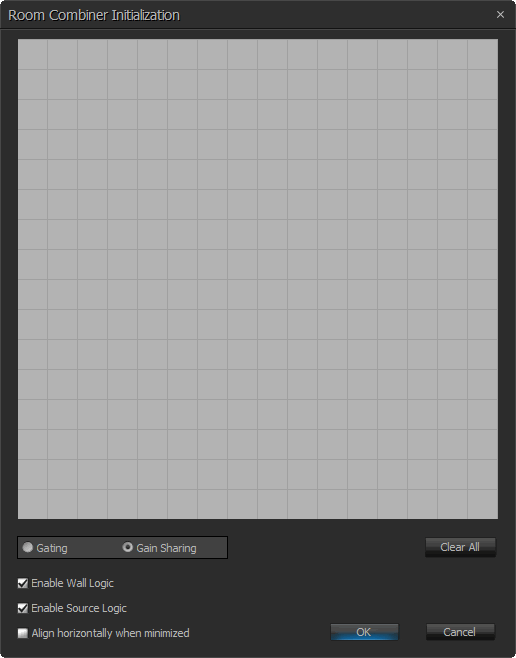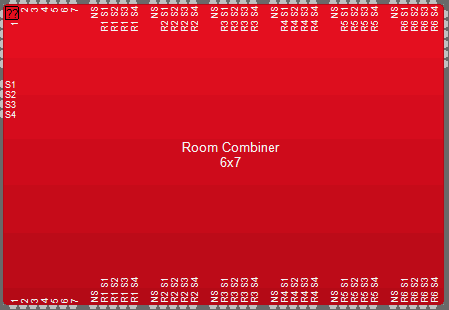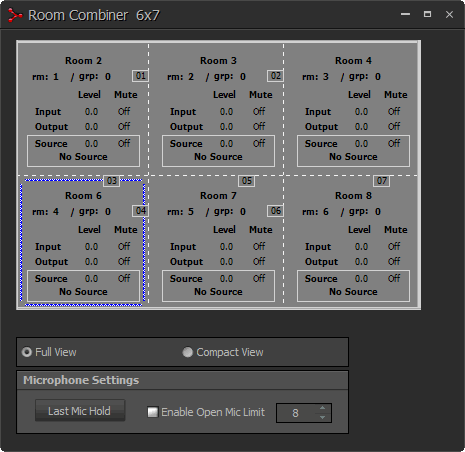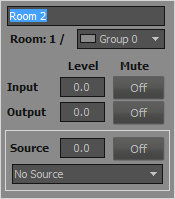Room Combiner
The Room Combiner block provides a way of managing the signal routing and control of combinable/divisible spaces. It can support a maximum of 32 rooms in numerous configurations, with combinable levels, mutes and source tracking. Logic inputs and outputs are provided for wall state and source selection, as well as the ability to combine and control the function of auto mixers connected to the Room Combiner block’s inputs.
Initialization Dialog
When a Room Combiner object is created from the Object Toolbar, an initialization dialog window is produced.

A 16 row by 16 column grid of blocks is used to lay out graphically the relative position of each room, so rooms that are combinable via a removable wall will share at least one border. Up to 32 unique combinable spaces can be defined. Enabled blocks in the grid that are adjacent to each other can have three types of walls: permanent, removable and none. The wall type is selected by repeatedly clicking on the border between adjacent enabled blocks. A removable wall is indicated by a thin dashed line, and the wall will have a corresponding logic node on the block. A permanent wall is indicated by a thick gray line and represents a non-removable border between those rooms. It will have no logic connection on the block. No border between adjacent enabled blocks indicates there is no wall, and the blocks will be considered part of the same space. The Clear All button removes all blocks from the grid.
The Room Combiner block can combine the function of auto mixers if their mix outputs are connected directly to the channel input nodes on the block. Select which type of auto mixer will be used by choosing Gating or Gain Sharing.
Enable Wall Logic controls whether the Room Combiner block will have logic connections for wall state. Enable Source Logic determines whether logic connections for source selection will appear on the block. Align horizontally when minimized controls whether the room information block will appear below (unchecked) or beside (checked) the room layout view when the Room Combiner control dialog is minimized.
DSP Block Representation

The Room Combiner block has one audio input and output per room. There are also four audio source inputs, which can be assigned to any room. If Enable Wall Logic and Enable Source Logic are checked when the block is created, the block will have a number of logic nodes on the top and bottom of the block. Numbered nodes correspond to the various removable walls in the block. A logic low signal presented to one of these nodes causes the corresponding wall to be removed and the two adjacent spaces to be combined. A logic high replaces the wall and uncombines the two spaces. Source selection logic inputs and outputs may also be shown. Four selections are provided per room, plus an Off node. When a source selection logic node receives a low-to-high transition (rising edge) that room’s source will switch to the corresponding selection.
More information on logic is located here: Room_Combiner_
Control Dialog
Double clicking on the Room Combiner block produces a control dialog window.

A graphical depiction of the rooms laid out in the initialization dialog is shown, with information about each room. Double clicking on a room opens its room edit dialog window.

The Room Name field can be used to specify a custom name for each room. The line of text below this shows the room number as assigned by the software. Room Group controls which combine group the room is assigned to. Rooms in the same combine group will output the audio stream of the combine group, which is a mix of the inputs of all rooms assigned to that group, and their output level and mute and source selection, level and mute will be linked. If a room is in combine group 0, it will be uncombined and operate independently. Input Level controls the volume of the input to the Room Combiner block. Input Mute turns the input signal on/off.
The following settings are linked with any other rooms in the same combine group. Output Level controls the volume of the channel output. Output Mute turns the output signal on/off. Source Level sets the volume of the selected source to that room. Source Mute turns the source input to the room off/on. Source selects which of the four source inputs is routed to that room. No source can be chosen as well.
When combining two adjacent rooms using the software control dialog, hovering on either side of a partition causes the mouse pointer to become a left or right pointing arrow, which will determine which room’s source selection will become the common source of the combined space when the partition is removed. When combining rooms via logic or the Room Combiner's Text Protocol (TTP), by default, the lower numbered room’s source is used as the common source, although this can be changed by using the Wall Room Precedence TTP command, preferredRoom.
When two rooms are combined, if either room’s Output Mute or Source Mute is enabled, the corresponding controls in the resulting combined space will also be muted. Also, if Output Level or Source Level controls differ, the lower of the two levels will be used in the combined space.
Use the view selection buttons at the bottom of the Room Combiner control dialog to display the Full View or the Compact View, which shows a room information field at the bottom to enable a smaller display.